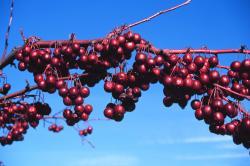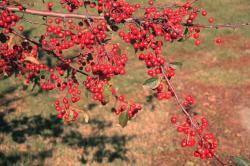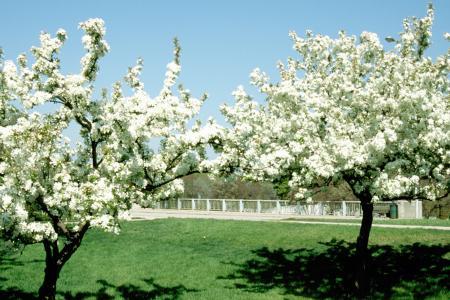June 27, 2013
| Malus Flowering Crabapple
|
| Description | Spring has certainly come when the crabapples are in full bloom, the pollinators busily visiting each blossom. The autumn fruit display can be almost as stunning. There are many bloom colours, fruit colours and tree forms from which to choose. With carefully chosen cultivars, your crabapple should resist fireblight, scab or Japanese beetles. |
| Usage | Virtually anywhere; street tree, patio, parking island, specimen. |
| Origin | Asia, Europe, North America |
| Hardiness zone | 3,4 |
| Size | 3-8m depending on species or cultivar |
| Form/texture | Various, depending on cultivars; rounded, vase-like, columnar, weeping. |
| Growth rate | Slow to moderate. |
| Leaf | Alternate, simple, rarely 1-2 lobed. |
| Flower | The reason people plant Malus; incredibly showy in white, pink and red shades. |
| Fruit | Varying sizes with cultivar; 1-4.5 cm diameter. |
| Exposure/culture | Best in full sun. Tolerant of all soils, alkaline to acidic, drought or occasionally wet. There are hundreds of cultivars. Tolerance to salt, diseases and pests varies with each cultivar, season and sometimes where the individual plant is grown. Tolerant of extremely dry soils. Moderately sensitive to deicing salt (Beckerman et al). Consult local authorities to choose a fireblight or scab resistant cultivar for your area. |
| Comments | Factors to consider are:
For local recommendations, ask your local garden centre. Some possible choices include: M. sargentii, 'Centurion', 'Harvest Gold', 'Spring Snow', 'Sugar Tyme', 'White Angel'. |



Reference:
Beckerman, J. and B.R. Lerner. 2009. Salt Damage in Landscape Plants. Purdue Extension Publication ID-412-W. Purdue University. West LaFayette, IN.
Fiala, J.L. 1994. Flowering Crabapples. Timber Press. Portland, OR.
Bassuk, N., D. F. Curtis, B.Z. Marrance, and B. Neal. 2009. Recommended Urban Trees: Site Assessment and Tree Selection for Stress Tolerance. Urban Horticulture Institute. Ithaca, NY.
http://www.hort.cornell.edu/uhi/outreach/recurbtree/index.html
Gerhold, H. 2007. Crabapple Cultivars Tested as Street Trees: Third Report . Arboriculture and Urban Forestry 33(3): 176-181.
Iles, Jeff. Crabapples for Midwestern Landscapes. http://www.ipm.iastate.edu/ipm/hortnews/2000/5-5-2000/crabapples.html
